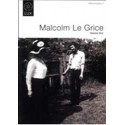DVD including five of Malcolm Le Grice's most important early works.
 Our terms and conditions of use
Our terms and conditions of use
(edit with the Customer Reassurance module)
 Delivery policy
Delivery policy
(edit with the Customer Reassurance module)
Malcolm Le Grice is one of the central figures in British experimental film and video. He has been making work since the mid-1960s which has continued to be exhibited internationally, including recent screenings at both Tate Modern and Tate Britain. He is currently a professor at the University of the Arts London, and is the author of several books including Experimental Cinema in the Digital Age (2001). You can read more about Malcolm Le Grice on LUX Online.
This DVD includes five of his most important early works:
LITTLE DOG FOR ROGER, 1967, 12 min, b/w, sd
"Little Dog For Roger is made from some fragments of 9.5 home movie that my father shot of my mother - myself, and a dog we had. This vaguely nostalgic material has provided an opportunity for me to play with medium of celluloid and various kinds of printing and processing devices. The qualities of film the sprockets the individual frames the deterioration of records like memories, all play an important part in the meaning of this film." MLG
BERLIN HORSE, 1970, 9 min, col, sd Sound by Brian Eno.
"This film is largely filmed with an exploration of the film medium in certain aspects. It is also concerned with making certain conceptions about time in a more illusory way than I have been inclined to explore in many other of my films. It attempts to deal with some of the paradoxes of the relationships of the "real" time which exists when the film was being shot, with the "real" time which exists when the film is being screened, and how this can be modulated by technical manipulation of the images and sequences. The film is in two parts joined by a central superimposition of the material from both parts. The first part is made from a small section of film shot by me in 8mm colour, and later refilmed in various ways from the screen in 16mm b/w. The b/w material was then printed in a negative positive superimposition through colour filters creating a continually changing 'solarization' image, which works in its own time abstractly from the image. The second part is made by treating very early b/w newsreel of a similar subject in the same way. As a two screen film the second screen has a b/w version of the whole film." MLG
THRESHOLD, 1972, 17 min, col, sd
"Threshold, made five years later, aptly offers points of comparison with Little Dog For Roger. Le Grice no longer simply uses the printer as a reflexive mechanism, but utilises the possibilities of colour-shift and permutation of imagery as the film progresses from simplicity to complexity. The initial use of pure red and green filters gives way to a broad variety of colours and the introduction of strips of coloured/celluloid which are drawn through the printer begins to build an image which becomes graphically and spatially complex - if still abstract - and which evokes the paintings of, say, Clifford Still or Morris Louis. With the film's culmination in representational, photographic imagery, one would anticipate a culminating 'richness' of image; yet the insistent evidence of splice bars and the loop and repetition of the short piece of found footage and the conflicting superimposition of filtered loops all reiterate (as in Little Dog) the work which is necessary to decipher that cinematic image." - Deke Dusinberre.
WHITCHURCH DOWN (DURATION), 1972, colour, 10 min, col, sd
"This film is the beginning of an examination of the perceptual and conceptual structures which can be dealt with using pure colour sequences in loop forms with pictorial material. In this case the pictorial material is confined to three landscape locations, and the structure is not mathematically rigorous." MLG
AFTER LUMIERE - L'ARROSEUR ARROS, 1974, 12 min, col, sd
"Though shot in 1974 before After Manet, its conception post-dated all the preparatory work for that film. It handles in a single screen way a similar area of problematic relying more evidently on speculation by the audience of the 'out of shot' state of affairs, and on the expected development of the work. Like the Manet film, it is based loosely on another work, in this case adding a character who does not feature in the Lumiere film. Both works are concerned with cinematic procedures and with the audience procedure in structuring the material." MLG




